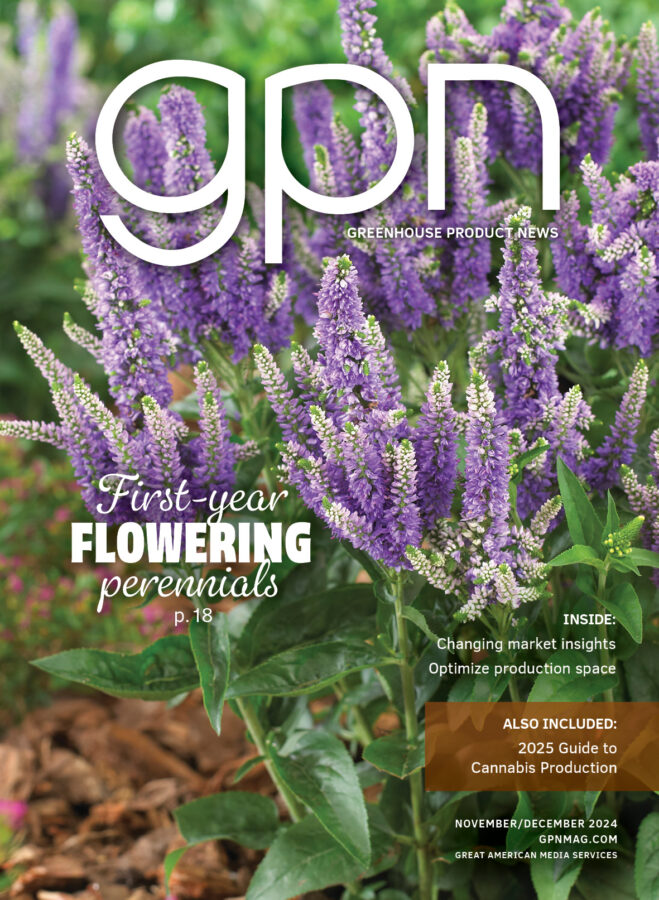Feeding For Growth
While visiting a grower the other day and going over his crop of pansies, mums, and flowering kale and cabbage, the main comment I had was that the plants looked like they needed more feed for growth to cover up the pots. The grower said he was feeding but was using 13-2-13 fertilizer. Normally this fertilizer is fine for most plants, but this was late August and early September. The weather was moderately warm with lots of sunshine good weather for growing plants. What I noticed was a lack of size and leaf expansion in his plants, along with lower yellow leaves on flowering kale and cabbage. I recommended the grower feed for the next week or so with 20-10-20 to get more leaf expansion and color. What the grower was concerned about was losing control of growth by using too much ammoniacal nitrogen feed. This is a legitimate concern during lower light periods, but not at this time.
I do see many cases of growers using fertilizers high in ammoniacal nitrogen and phosphorus and not controlling the shoot growth during late winter and spring. But I also see quite a few instances of growers not using enough ammoniacal nitrogen and phosphorus during high light periods, when the plants are working hard to expand their leaves. During these times, you need to work in some 20-10-20 or similar fertilizer with enough ammoniacal nitrogen and phosphorus. At other times of the year, fertilizers higher in nitrate nitrogen and calcium will be fine. The trick is to know what you need and when and to recognize if you are getting the right type of feed into the plant.
Fertilizer Effects On Growth
The primary purpose of any fertilizer is to promote growth, whether in roots, shoots or flowers. There are a number of nutrients involved in plant growth. The main nutrients are nitrogen, phosphorus, potassium, calcium, magnesium and sulphur. The minor nutrients include iron, manganese, boron, zinc, copper and molybdenum. When you look at a fertilizer bag, you usually see three numbers (i.e., 20-10-20). These numbers indicate the amount of nitrogen, phosphorus and potassium. Some newer fertilizers will have five numbers on the bag, with the last two indicating calcium and magnesium (i.e., 13-2-13-6-3).
There are three forms of nitrogen that can be used in fertilizers: ammoniacal, nitrate and urea. For simplicity sake, we group ammoniacal and urea together, as both must be broken down by bacteria in the Á soil to be totally used by plants. This process is governed by soil temperature, with best activity above 60º F. The nitrate form is readily taken up by plant roots, even at cooler temperatures. So, when growing plants less than 60º F, use a fertilizer high in nitrate nitrogen to avoid salt buildup and ammonium toxicity. The ammoniacal and urea forms of nitrogen promote rapid shoot growth, bigger and greener leaves, more vegetative growth and softer plants. The nitrate form of nitrogen promotes more toned shoot growth, better roots and more reproductive growth. Figure 1, right, lists some common fertilizers and what percentage of total nitrogen is in ammoniacal and urea forms of nitrogen. You can see from this list that 20-10-20 has 40 percent of total nitrogen as ammoniacal, whereas 13-2-13 has 11 percent of total nitrogen as ammoniacal. What this means is that 20-10-20 will promote more vegetative growth than 13-2-13, regardless of light levels. Essentially, you are feeding with a higher-octane gas as you go up this list.
Another nutrient critical for growth and flowering is phosphorus, the middle number of a fertilizer. Paul Nelson at NC State University has shown through his research that higher levels of phosphorus promotes more stretch in plugs than high levels of ammoniacal nitrogen; however, phosphorus is also essential for flowering and overall energy levels in plants. When growing young plants, you should use a fertilizer from the bottom half of the list, as they are low in phosphorus. But make sure you have some phosphorus in your fertilizer after transplanting to help with growth and flowering. The use of 9-45-15 is common in field transplanting to boost phosphorus, which is typically low in field soils.
Not all fertilizers have calcium and magnesium, as shown in Figure 1, page 24. Fertilizers high in phosphorus have no calcium, as this nutrient would combine with phosphorus and precipitate out. Calcium is needed for good roots, thicker stems and leaves, and fruit development, and it is taken up by the plant with water. This means as the plant loses water through transpiration, it takes up water and therefore calcium, through the roots. Humid weather and low light conditions inhibit calcium uptake. Calcium is also not translocated well throughout the plant. Poinsettia bracts can show bract edge burn due to calcium not being translocated all the way up to the bracts. Foliar sprays of calcium are beneficial in these cases. Finally, high levels of potassium can inhibit calcium uptake.
Magnesium is needed for chlorophyll (green pigment of leaves) and photosynthesis. If you are using a fertilizer from the bottom half of Figure 1, page 24, it is no longer necessary to supplement magnesium with Epsom salt drenches. High levels of calcium can inhibit magnesium uptake.
When choosing a fertilizer, it is important to know not only what it will do for plant growth but also how it will affect media pH. Figure 2, above, shows what nutrients are affected by low or high media pH when growing in peat-based media. The only reason we are concerned about media pH is nutrient availability. If your media pH is out of whack, a soil test could show that the nutrients are there, but a tissue test will show a deficiency. This is because media pH can tie up nutrients when not in the proper range.
Figure 1, page 24, shows the effects of different fertilizers on Á media pH (potential acidity or basicity). When using all 13-2-13 to control growth, you will end up raising media pH, maybe too high. Indicator crops of high media pH include vinca, snapdragon, petunia, pansy, primula, dianthus and calibrachoa. Symptoms of high media pH can include upper yellow leaves, tip abortion, thick distorted new leaves and stunting. Growers using 20-10-20 will end up lowering media pH, maybe too low. Crops quick to show low media pH problems include seed and zonal geraniums, African marigold, penta, lisianthus and New Guinea impatiens. Symptoms of low media pH can include lower leaf necrosis, stunting, hard cupped-down leaves or overall yellowing.
Interpreting Feed Problems
Now that we have covered the types of fertilizers and their effects on plant growth and media pH, let’s go over how to diagnose nutritional problems. I am not going to cover all types of nutrient deficiencies, only how to basically determine if you are feeding properly.
If plants are showing lower yellow or purple leaves, check the roots first (Figure 3, page 28). Root rots can prevent nutrient uptake. If roots are fine, then check media EC to see if there is enough gas to the plant. With well-developed root systems, it is not uncommon to find lower yellow leaves on many crops. Keep your feed levels up during warmer weather, and use growth regulators to control the height.
If plants are showing upper yellow leaves, check the roots first (Figure 3, page 28). Root rots will inhibit iron uptake, resulting in interveinal chlorosis of upper leaves. If roots are good, then check media pH. High pH will tie up iron. Some crops, such as calibrachoa and vegetative petunias are high-iron users.
If plants are small and leaves are not expanding enough, check the roots for root rots (Figure 3, page 28). Next, check to make sure you did not over-apply chemical growth regulators. Then, check media pH and EC. During high light periods it is common to not feed with enough ammoniacal nitrogen to get the leaf expansion needed. I see problems with light-green-leaf poinsettia varieties every year, where growers do not feed enough to get good color to leaves. However, their dark-green-leaf varieties do fine.
Finally, if plants are tall and soft, check the roots (Figure 3, page 28). During low light conditions, you can easily get more shoots than roots. Wet growers will have more problems with this situation, as well as more root rots. Or maybe you missed a growth regulator application. Check the type of fertilizer being used, and switch to one from the bottom half of the list if not already using one. Under conditions of low light it is easy to overfeed plants, turning them into fat “couch potatoes.” Plants do not grow rapidly under low light and therefore, require less feed. But plants growing under high light are like athletes in training, meaning they burn up a lot of calories that need to be replaced by ammoniacal nitrogen and phosphorus.
Some plants require higher levels of feed to grow properly. These include gerbera, mum, poinsettia (first half of crop cycle), flowering kale and cabbage, lisianthus, geranium and vegetative petunia. Other plants are low-feed crops and, when fed too much, will either lose roots with high media EC or get too soft. These include impatiens, pansy, primula, cyclamen, poinsettia (second half of crop cycle), snapdragon (grown inside) and vinca.
Monitor your crops closely with at least weekly media pH and EC tests done in-house and supported by monthly lab tests on key crops or whenever plants show a problem. Look at your plants closely to determine if the leaves are expanding enough with good color. Keep an eye on your root-to-shoot ratio for each of your crops, whatever the season. You can speed up or slow down plant growth by your choice of fertilizer but always remember what that fertilizer will do for media pH as well.


 Video Library
Video Library 



















